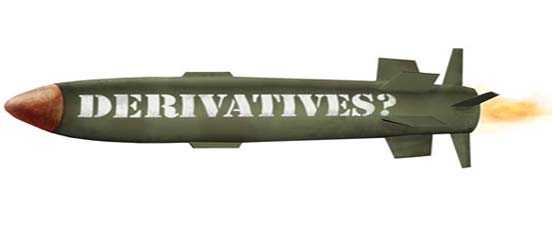No one really knows
how much damage could be done by an unwinding in the derivatives market, but the
total exposure (potential losses) may be as high as 700 Trillion
dollars (yes that is with a T). JP
Morgan alone may have as much as $90 trillion exposure. Other financial institutions such as Goldman
Sachs, Citigroup, RBS , UBS and RBC all have large exposures.
 |
| Photo:
|
What the Heck is a
Derivative?
Tough question to
explain, but here is a simple example.
Farmers are planting
wheat in the spring. They do not know what success they will have this year.
Next to them is a flour mill which will grind their wheat. Down the road is an investor, and he would
like to make money off the wheat crop without doing work, but he is willing to
take some financial risk.
The investor tells the
flour mill the owner “It is only the spring, but I will give you money now in
exchange for letting me control who uses your mill in the fall.”
The owner of the mill
accepts the money, reasoning that he can make an average year’s profit for his
mill off just this one investor, even if the crop fails completely.
The crop is successful
and the farmers arrive at the mill. The investor charges them to gain access to
the mill and the mill grinds the wheat into flour.
The investor makes
money by charging the farmers more than they would have paid the mill owner,
but the investor now controls access to the mill for the season, so the farmers
have no choice.
The investor made
money not through his labour (the farmer) or by offering a service (the mill
owner). The investor derived his money (i.e. a derivative) by essentially betting that
the price of wheat would stay high and the crop would be good. If the crop had failed completely, the
investor’s derivative would have failed and he would have lost all his
money.
So, in economic terms,
a derivative is a contract
whose value is derived from the performance of underlying market factors, such
as market securities, indices, interest rates or equity prices. In this case, the underlying factor was the
amount of wheat to be produced and its price which was not known in the spring
of the year.
Can Derivatives
be a Good Thing?
Yes. Consider a medium sized trucking company that
has just received a major contract for two years of shipping. They are worried that they could lose money
on the contract if the price of diesel fuel goes up suddenly. They approach an
investor for a derivative. The investor
agrees to guarantee the price of fuel to the trucking company for the next two
years. The price of the fuel will be higher than the current market price, but
the trucking company believes they can still make a profit, even at the higher
price, so this is good for them. The investor believes that the various rises
and falls in diesel prices will allow him a profit.
In this case, the
trucking company has been able to outsource its risk (fuel price) to an
investor in order to sign the contract with confidence.
Why did
Derivatives Turned out to be Dangerous?
The key issue
lies in the outsourcing of risk. An intelligent use of derivative can allow a
business to outsource its risk. Unfortunately, the folks on Wall Street and in
The City have found increasingly complex methods of using derivatives to outsource
risk. They believe that they can be
almost risk free by covering all their investment risks with derivatives.
They have done
this so much, there is now believed to be some 700 trillion dollars worth of
derivative contracts out there – most of which are beyond the understanding of
those who supposedly regulate finance markets. The risk involved is also beyond
the understanding of the financial institutes involved.
The Killer
The financial
institutes such as JP Morgan, UBS and CITI believe they have outsourced risk. But here is the killer. Everyone
one of them is busy outsourcing risk by selling derivatives to other financial
institutes. In other words, they are all outsourcing their risk to each
other. This is a closed loop with a
finite amount of players. If everyone thinks they have outsourced their risk to
everyone else, then they are collectively holding all the risk. They are all vulnerable.
And then there are synthetic derivatives and synthetic derivatives combined with options trading, but might might be a story for another day.
Once again, we
may see the financial institutes lining up for more bailouts if this market unwinds.
This is economics
for the rest of us. Financial derivatives should be seen as a weapon of mass
destruction.
No comments:
Post a Comment